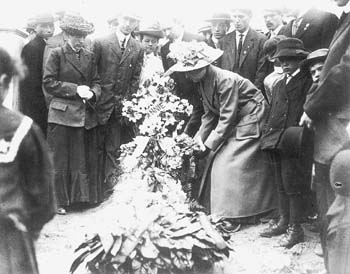![[MetroActive Features]](/features/gifs/feat468.gif)
[ Features Index | Metro Santa Cruz | MetroActive Central | Archives ]
Bread Winners
 The American Textile History Museum When Women Rose: Following the death of Anna LoPizzo, a 'Bread and Roses' striker shot by police, women workers like Consiglia Rocco Teutonica stepped into active roles in the famous Lawrence, Mass., uprising.
Consiglia Rocco Teutonica KNEADING FLOUR, WATER, olive oil and a pinch of salt into dough and leaving it to rise, and other rituals of bread baking, aren't usually considered acts of radical political activism. But for a young Italian immigrant named Consiglia Rocco and thousands of women, it was such everyday acts that fueled a rebellion. In 1912, more than 25,000 millworkers--half of them women--walked out of textile factories in Lawrence, Mass., in what would become known as the "Bread and Roses" strike. It would teach America a lesson about the power of immigrant women. The uprising began over a pay cut, which equalled the cost of five loaves of bread a week. Outraged workers also called for their rights as women, workers, immigrants and, in many cases, children. And they demanded respect, too: "We not only wanted labor laws and bread," said one striker, "we wanted roses, too." Consiglia Rocco was only 14 when the strike began on Jan. 11. The strikers--largely Russian Jewish, Eastern European and southern Italian immigrants, although 54 languages were spoken in the mills--learned the art of mass protest. Forming a human chain, they took over the main streets of Lawrence on Jan. 29. After failed attempts to disperse strikers by dousing them with water in the freezing January cold, officers fired into the crowd. A young Italian woman, Anna LoPizzo, was killed. News reports from the time focused on predictions about the "ascendancy of white-skinned races" in Lawrence. They promised that illiterate immigrants couldn't possibly organize themselves on their own. But in the immigrant communities of Lawrence, the Roccos and others were already setting up a strike-support system. Consiglia and her mother, known as "Grandmama" to the strikers, transformed their weekly bread-baking rituals into planning meetings. Like many Russian Jewish and Italian families, the Roccos turned their home into a free day-care center and soup kitchen for protesters. While her mother attended protests, young Consiglia cared for the neighborhood kids. Mill owners who had predicted a quick end to the strike after LoPizzo's death were surprised when, a few days later, a group of enraged Italian women happened upon a lone police officer on an icy bridge. After stripping him of his gun, club and badge, they sliced the officer's suspenders and took off his pants--a humiliation technique popular with the disorderly women of Lawrence--and dangled the officer over the freezing river. That put an end to any hope that they would quickly scurry back to work. Years later, after Consiglia married and became Consiglia Teutonica, she helped historian Ardis Cameron piece together oral histories of the Bread and Roses strike. She told of a protest following LoPizzo's death when soldiers again drew their guns and bayonets. According to Teutonica, this time a 22-year-old Syrian immigrant named Annie Kiami stepped in front of the crowd. Calling the soldiers "Cossacks," Kiami wrapped an American flag around her body and dared them to shoot holes in Old Glory. Once thought of as docile and subservient, the Bread and Roses women quickly gained the notorious title among mill owners of radicals of the worst sort. "One policeman can handle 10 men," Lawrence's district attorney lamented, "while it takes 10 policemen to handle one woman." In the words of one horrified boss, the women activists were full of "lots of cunning and also lots of bad temper. They're everywhere, and it's getting worse all the time."
If he had only known. [ Santa Cruz Week | MetroActive Central | Archives ]
|
From the March 10-17, 1999 issue of Metro Santa Cruz.
Copyright © Metro Publishing Inc. Maintained by Boulevards New Media.